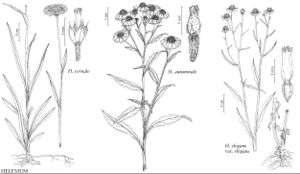Difference between revisions of "Helenium"
Sp. Pl. 2: 886. 1753.
Gen. Pl. ed. 5, 377. 1754.
imported>Volume Importer |
RevisionBot (talk | contribs) m (Bot: Adding category Revised Since Print) |
||
| Line 258: | Line 258: | ||
}}<!-- | }}<!-- | ||
| − | -->[[Category:Treatment]][[Category:Asteraceae (tribe Heliantheae) subtribe Gaillardiinae]] | + | --> |
| + | |||
| + | [[Category:Treatment]] | ||
| + | [[Category:Asteraceae (tribe Heliantheae) subtribe Gaillardiinae]] | ||
| + | [[Category:Revised Since Print]] | ||
Latest revision as of 15:32, 15 December 2020
| Taxon | Illustrator ⠉ | |
|---|---|---|
 | Helenium vernale Helenium autumnale Helenium elegans var. elegans | Yevonn Wilson-Ramsey Yevonn Wilson-Ramsey Yevonn Wilson-Ramsey |
Annuals or perennials, 10–160 cm. Stems 1 (–10), erect, simple or branched distally (usually ± winged by decurrent leaf-bases), glabrous or sparsely to densely hairy. Leaves usually mostly cauline; mostly alternate (proximal sometimes opposite); petiolate or sessile; blades mostly elliptic, lanceolate, linear, oblanceolate, oblong, ovate, or spatulate, often pinnately lobed or pinnatifid, ultimate margins entire or toothed, faces glabrous or sparsely to densely hairy, gland-dotted. Heads radiate or discoid, borne singly or (2–300+) in paniculiform to corymbiform arrays. Involucres ± globose, hemispheric, obconic, or ovoid, 4–34 mm diam. Phyllaries persistent, 9–34 (–40+) in (1–) 2 [–3] series (distinct or proximally connate, usually reflexed in fruit, glabrous or sparsely to densely hairy, gland-dotted). Receptacles conic, ± globose, hemispheric, or ovoid, pitted (glabrous), epaleate (rarely bearing setiform enations). Ray-florets 0 or 7–34, pistillate and fertile or neuter; corollas yellow, yellow with purple streaks, reddish-brown to red proximally and yellow distally, or reddish-brown to red or purple throughout. Disc-florets 75–1000+, bisexual, fertile; corollas yellow, purple, or yellow to yellow-green proximally and yellowbrown, brown or reddish-brown to purple distally, tubes shorter than throats, lobes 4 or 5, ± deltate (style-branch apices penicillate or truncate). Cypselae mostly obpyramidal, 4–5-angled, glabrous or sparsely to densely hairy; pappi persistent, of 5–12 entire or ± lacerate, sometimes aristate scales. x = 17.
Distribution
North America, Mexico, West Indies (Cuba), Central America, South America
Discussion
Species ca. 32 (18 in the flora).
Helenium polyphyllum Small is apparently a hybrid between H. autumnale and H. flexuosum.
Selected References
Lower Taxa
Key
| 1 | Stems not winged | Helenium amarum |
| 1 | Stems ± winged (by decurrent leaf bases) | > 2 |
| 2 | Ray florets usually 8–34, neuter (if rays 0, perennials from e or se United States) | > 3 |
| 2 | Ray florets usually 7–30, pistillate, fertile (if rays 0, plants either perennials from w United States or annuals) | > 8 |
| 3 | Heads 1(–3); disc corollas mostly yellow, sometimes yellow-brown distally | > 4 |
| 3 | Heads 1–80+; disc corollas usually purple, sometimes red-brown or yellow-brown distally or throughout | > 6 |
| 4 | Pappus scales deeply lacerate; e Texas, sw Louisiana | Helenium drummondii |
| 4 | Pappus scales entire or slightly lacerate (never deeply lacerate); se Louisiana, s Mississippi, s Alabama, s Georgia, se South Carolina, s North Carolina, Florida | > 5 |
| 5 | Leaves of basal rosettes usually pinnatifid; peduncles hairy; cypselae hairy | Helenium pinnatifidum |
| 5 | Leaves of basal rosettes usually entire; peduncles usually glabrous, sometimes sparsely hairy; cypselae glabrous | Helenium vernale |
| 6 | Heads (1–)5–50(–80); pappi of aristate scales | Helenium flexuosum |
| 6 | Heads 1–20; pappi of non-aristate scales | > 7 |
| 7 | Stems densely hairy proximally; leaves moderately to densely hairy; pappi 0.3–0.5 mm; nc Arkansas | Helenium campestre |
| 7 | Stems glabrous proximally; leaves glabrous or sparsely hairy; pappi 1–1.7 mm; se United States | Helenium brevifolium |
| 8 | Perennials | > 9 |
| 8 | Annuals | > 13 |
| 9 | Stems unbranched or sparingly branched distally | > 10 |
| 9 | Stems strongly branched distally | > 11 |
| 10 | Peduncles usually densely hairy; pappi (2.5–)3–4.5 mm | Helenium bolanderi |
| 10 | Peduncles sparsely to moderately hairy; pappi 1.3–2.2(–2.7) mm | Helenium bigelovii |
| 11 | Rays usually 13–15, sometimes 0, corollas 3.8–10 mm; disc corollas yello to reddish brown or purple distally, lobes 4(–5) | Helenium puberulum |
| 11 | Rays 8–21, corollas 10–23 mm; disc corollas yellow to yellow-brown distally, lobes 5 | > 12 |
| 12 | Leaves: basal blades oblanceolate, obovate, or spatulate (withered by flowering), mid blades usually dentate, distal blades entire or dentate; United States and s Canada | Helenium autumnale |
| 12 | Leaves: basal blades oblanceolate (usually present at flowering), mid blades usually entire, sometimes dentate; swampy meadows, Missouri, Virginia | Helenium virginicum |
| 13 | Pappi of aristate scales | > 14 |
| 13 | Pappi of non-aristate scales | > 16 |
| 14 | Disc corolla lobes 4(–5); California | Helenium puberulum |
| 14 | Disc corolla lobes 5; Arizona, Texas | > 15 |
| 15 | Stems weakly winged (leaf bases scarcely decurrent from node to node); cypselae 2–2.9 mm; n Arizona | Helenium arizonicum |
| 15 | Stems narrowly winged (leaf bases decurrent from node to node); cypselae 1–1.2 mm; s Texas | Helenium linifolium |
| 16 | Involucres globoid and distal leaves entire | Helenium elegans |
| 16 | Involucres usually ovoid to obconic (if globoid, distal leaves serrate to undulate-serrate) | > 17 |
| 17 | Distal leaves serrate to undulate-serrate; disc corolla lobes (4–)5 | Helenium microcephalum |
| 17 | Distal leaves entire; disc corolla lobes 4 | > 18 |
| 18 | Rays 10–15 | Helenium quadridentatum |
| 18 | Rays 0 | Helenium thurberi |